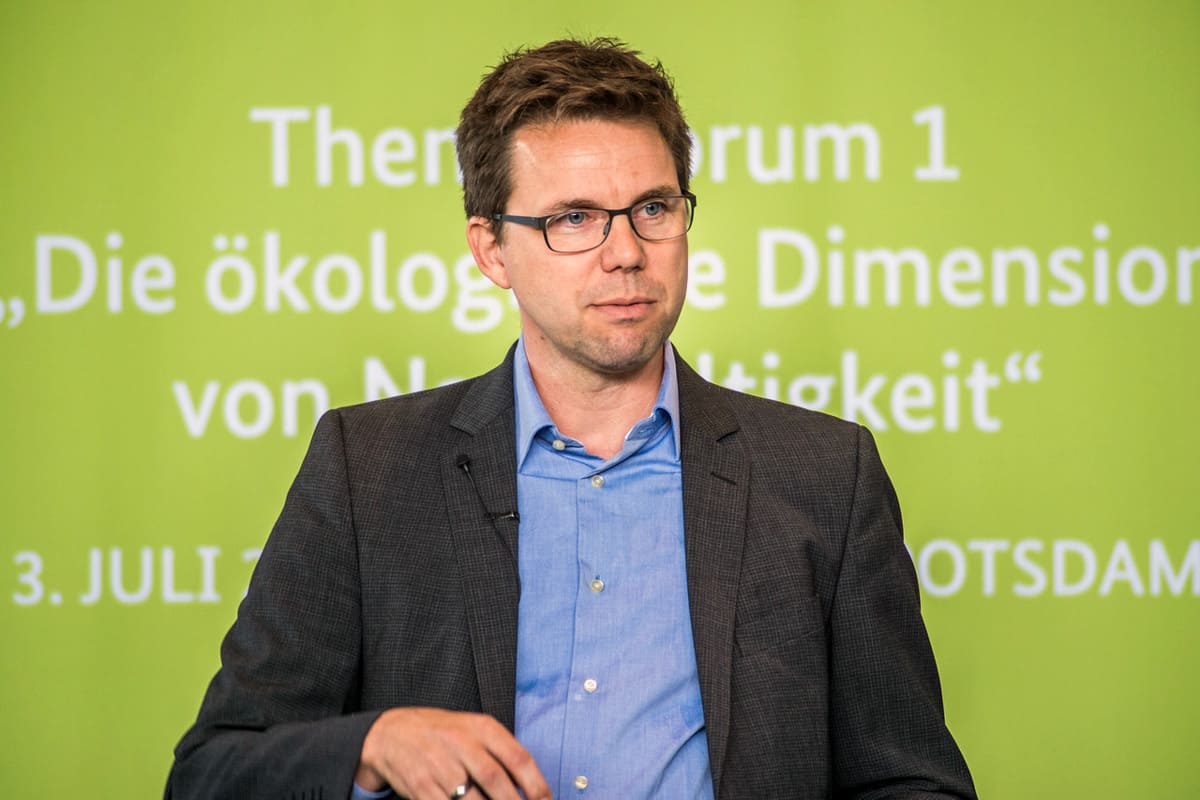Leadership | Core Elements of Effective Leadership
The essence of effective leadership
From Sabine Walter, Head of netzwerk managementberatung | coaching
The understanding of successful leadership has changed over the last decades. This supposed proof is provided by numerous models and extensive leadership literature. I have been involved in leadership for more than 20 years, have led for years myself and have been successfully advising leaders for 15 years on how to lead effectively and be successful with their organisation. The essence of effective leadership, which for me is independent of the model, is based on this experience. This is what this article is about.
Essence of effective leadership
What makes good leadership?
In my experience, leadership is effective when it understands how to balance three areas over and over again: Market & society, organisation and people.
These are the source of entrepreneurial issues which define the central cornerstones of effective leadership:
- What problem do we want to solve through our range of products and services?
- What contribution do we want to make to society?
- How do we do this in a value-creating and productive way?
- Who do we need for this to succeed in the long term with expertise, commitment and responsibility?
Of course, the answers to these questions are many and varied. This also underlines why, in my opinion, effective leadership cannot be pressed into models. Effective leadership is always situational or contextual. And people always lead - different people with their own personalities.
Characteristics of effective leaders
What are the characteristics of good leaders?
We work with very different leaders in the context of our leadership and organisational development mandates. The question we have asked ourselves in this context is: What are the hallmarks of effective leaders who are able to continuously solve real problems with their team in a productive and value-adding way, relying on committed employees who bring all their expertise to this problem-solving?
Effective leaders have five critical qualities which they use with varying intensity depending on the situation and which they link together in the most diverse ways:
- Trust
- Clarity
- Appreciation
- Decision-making power
- Space for participation & development
Let's look at these qualities in detail.
Characteristics of effective leaders
Trust
Trust is expressed on four levels: feeling, seeing, speaking and acting. And that's not all. All actors who interact with each other inside and outside an organisation have these four levels. So it is always about one's own feeling, seeing, speaking and acting and that of others. This also means that all four levels permanently influence the basis of trust - both positively and negatively. Continuous trust-building is therefore needed at these levels in order to maintain trust at a continuously high level.
Trust is at the core of effective leadership. Without trust, leadership will not be effective. Because a lack of trust always results in more control and unproductive conflicts - both of which cost time, money and quality.
In order to establish and maintain a stable culture of trust, leaders are required to lead the way and remain the driving force. What does that mean?
It means that they have to give everything so that others can trust them. This includes, among other things:
- Feel confidence in oneself and one's own actions (self-confidence) and radiate it so that others can feel, see and hear it.
- Giving others the benefit of the doubt
- Be authoritative in speech and action, the Americans say: "Walk the talk".
- Strengthening the self-confidence of others by trusting them to do something - i.e. also letting go and handing over tasks and decisions.
- Sincere praise and criticism
- Promote trust in decisions made by making decision-making processes transparent and talking about (interim) successes.
- Admit own mistakes
- Address when you have the feeling that the other person does not trust you and look together at how trust can be built up.
- Have time for each staff member to get to know each other
- Approach others in an open and non-judgmental way, based on good intentions.
I would like to go into the point on intention in more detail, as it is a guiding principle for all of us. Therefore, the intention of managers should also be taken into account much more than before in their selection.
Aspects of trust
The intention
What is intention? And what does intention have to do with effective leadership? Let's approach the answer with a question:
With what intention do leaders lead? Or put another way: Why do they lead? To pursue a career? To earn more money? To have the title of boss on their business card? Because there is no one else or because they slipped into it? How many leaders lead because they are convinced that they have the qualities it takes to continually rebalance the aspects of effective leadership described above for their field or company and thus create something meaningful together with other people?
Steven Covey writes in his book "Speed through Confidence": "Our intentions consist of three factors: motives, agenda and action. ... And one motive that particularly inspires confidence is caring. This is about really caring about people and society as a whole, the purpose and quality of what you do." Let's be honest. Why do you lead, you personally? Because you really care about your team, the company and finding solutions to the problems of your customers or society?
Covey continues: "The agenda results from the motive. It is what you want to do because of your motive. The agenda that particularly inspires trust is the honest pursuit of mutual benefit, of what is best for everyone. Then you not only care about the others, but you really want everyone to win." An agenda based on a sympathetic and trusting motive is always open and transparent - never hidden. Why? Win-win solutions can only be achieved together in honest exchange. This brings us to the third point Covey names, action.
Covey writes: "Our actions express our motives and agendas." Because the action proves whether we really care about people and causes or whether we only pretend to. Of course, trust can also be gambled away if well-meant things are poorly implemented due to insufficient competence, but competence can be learned and developed. It is much more challenging to change intentions. Therefore, leaders who want to lead effectively are challenged to find out their real intentions. Questions that help them to do this are:
- Am I really concerned about the welfare of the company?
- Do I really want each of my team members to start their work with joy every morning?
- Is it really important for me to get to know and understand the people I work with on a personal level?
- Do I really want what is best for everyone? Do I know what is best for me and do I really understand what is best for others?
- How much do I really value the qualities and contributions of my staff?
- How important is it to me that each of my team members develops personally?
- Am I really ready to take on the responsibility that comes with my leadership role?
I could expand this list considerably, but I think you have gained an impression of what the aspect of "intention" is all about and why this aspect plays a central role in trust and thus also in effective leadership. Therefore, I come to another central point in the context of trust, self-confidence.
Self-confidence as the basis for relationship trust
Confidence in one's own self has a significant influence on how much relationship confidence - i.e. trust in others - a person has. People with low self-confidence usually also have low relationship confidence. People with low self-confidence will therefore tend to micro-manage and be much more controlling than people with high self-confidence.
The disadvantage of micromanagement among managers is not only that time becomes a scarce resource and the boss becomes a bottle neck. The disadvantage is above all that trust is damaged and with it personal development, commitment and sense of responsibility. Micro-management is the beginning of a process of stagnation and then shrinkage at all levels, personal, interpersonal, organisational, corporate and economic.
Another consequence of too little self-confidence is that other people are more likely to be accused of dishonest or bad intentions. Mistakes do not happen simply because mistakes happen. The assumption is that the mistake was made to harm oneself. This view - which tends to be characterised by fear and mistrust - destroys trust very quickly and also makes it almost impossible to find a constructive culture of conflict and communication in the team, which would be necessary to allow trust to grow again.
Therefore, a crucial contribution that leaders can make in the context of continuous trust work is to strengthen their own self-confidence.
Another aspect that also pays 1:1 to the trust level and thus to effective leadership is clarity.
Characteristics of effective leaders
Clarity
Clarity at different levels helps to provide security, reduce friction, increase productivity and reduce the potential for conflict. Where should clarity prevail everywhere?
Aspects of clarity
Target clarity
Target clarity is defined by the question: What should be achieved when and where? We recommend formulating these goals SMART, i.e. specific, measurable, attractive, realistic, timed.
It is important that there is clarity of purpose at all levels of the organisation and that there are no conflicting goals.
Clarity in terms of roles, responsibilities and decision-making powers
Lack of clarity in roles, responsibilities and decision-making powers causes conflicts, lowers productivity, provokes duplication of work and blind performance. Therefore, it is important to clearly define who is responsible for what and what should be achieved and may be decided within the framework of this responsibility.
Clarity in relation to decision-making processes
How are decisions made within the framework of the defined decision-making competencies? Who is heard? Who is actively involved in decision-making? What is the voting procedure for group processes? Who has a right of veto? Who is informed after the decision and how?
Clarity in language
This clarity must also be expressed in clear language, language without softeners, such as: actually, one should, possibly, maybe, if there is time.
It is important for clarity that all people in an organisation have the same understanding of the points mentioned, i.e. that misunderstandings are eliminated and open questions are clarified.
Clarity in being and acting (authenticity)
The clarity that effective leaders have on the outside results from a clarity on the inside. This makes them authentic. This authenticity also helps others to trust these people more easily.
Characteristics of effective leaders
Appreciation
Appreciating people, achievements and results sincerely, is another quality of effective leaders. Incidentally, this includes appreciation of oneself and implies a perception that is directed towards the positive rather than the negative.
At this point, I would like to bring the aspect of "intention" into play once again, as the intention with which appreciation is expressed is crucial to whether or not it pays off in terms of effective leadership.
I can give praise with different intentions. With the favourable intention, the other person is at the centre of my actions. The praise is sincere. But if praise is given with strategic or even manipulative intent, it is about the giver of praise. Praise is used to achieve something. Examples of this are:
- Praise is used to initiate criticism
- Praise is used to receive praise in return
- Praise is used to get the other person to do something that he or she actually rejects.
Insincere praise will permanently weaken leadership effectiveness and destroy trust. Therefore: when you praise, praise sincerely.
Of course, appreciation can also be expressed implicitly, for example, by respecting the opinions or decisions of others - even a "no". Listening and taking time are expressions of appreciation, giving responsibility or space. Involving others in decision-making processes can also be an expression of appreciation.
This brings us to the next quality of effective leaders, decision-making power.
Characteristics of effective leaders
Decision-making strength and speed
Decision-making power is influenced by two factors: on the one hand, self-confidence and, on the other, the demand for perfection.. "Decisions we make have to be perfect or lead to the "perfect" result." This, dear leaders, is a misconception and paralyses every organisation.
If you want to continuously balance the three aspects of effective leadership, then you are constantly challenged to make decisions. Even if you are not one hundred per cent sure where this decision will lead and therefore there is a big chance that (in a first step) there will not be a perfect result.
To gain greater confidence in decision-making, six questions can help:
- What is the worst that can happen if the decision is inadequate?
- Can we live with these consequences?
- What can we do to correct the decision?
- When would we have to make this correction at the latest?
- What are the consequences if we make the decision too late?
- Can we live with these consequences?
Decisions are critical when they put people and companies at risk or permanently destroy trust. All others Decisions are worth making, even under uncertainty, in order to get into action and, if necessary, to learn from the decisions made.
Characteristics of effective leaders
Space for participation & development
Creating space for participation and development goes hand in hand with dispensability. This may sound paradoxical, but effective leaders ensure that they are dispensable by supporting others in their development. They create a space where each team or organisational member can be effective and develop.
This in turn presupposes a certain attitude: effective leaders see others as equivalent and mature. equivalent and mature.
Space for participation and development can be created in various ways, e.g. by transferring (budget) responsibility and decisions, assigning new tasks, allowing people to develop and try out their own ways and approaches. But part of it is also:
- Allowing mistakes and failure
- Experimentation and scope to try things out
- Have processes and structures designed
- Give constructive feedback
- Create opportunities for further education
- Help shape the corporate vision and strategy or
- Discuss goals together
- Accept that others are allowed to make their own experiences, even if one knows oneself that the planned path will not lead to the goal.
And this quality of giving others space for participation and development also requires a benevolent intention and is significantly influenced by the prevailing culture of trust in organisations. Because: Development takes place outside of one's own comfort zone and people leave this zone when they feel emotionally safe, i.e. when they have trust in their environment.
At this point, let me add a word to the entrepreneurs who are aiming for a generational change in their company in the foreseeable future. In this case, giving the successor or successors room for participation and development also means handing over one's own life's work unconditionally - completely trusting that the successors will use it in whatever form and develop something of their own that creates meaning.
Conclusion
Effective leadership is characterised by five central qualities
Effective leadership is independent of leadership models. It is able to balance the three central elements of market & society, organisation and people again and again. For this to succeed, leaders essentially need five qualities:
- Trust
- Clarity
- Appreciation
- Decision-making power
- Space for participation & development
These qualities are underpinned by a benevolent intention that places the well-being of the company and the people interacting with it at the centre of action. If we succeed in making this benevolent intention an elementary part of the understanding of leadership, many challenges we have as a society could be solved. Because leaders who put the well-being of people at the centre of their actions will be respectful and moderate in their use of resources - both with people and with the environment.



